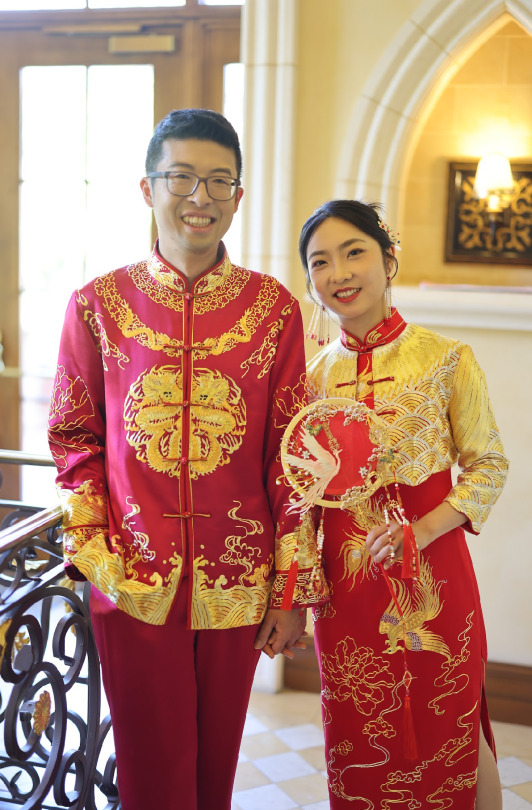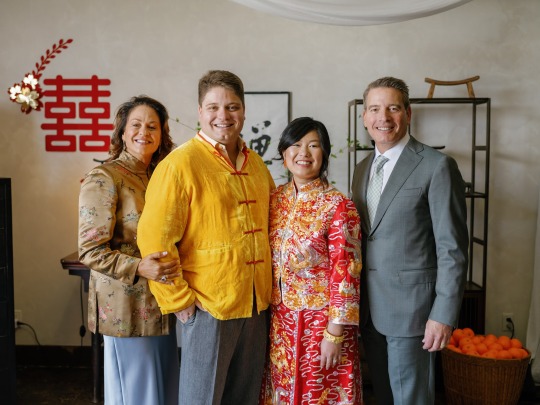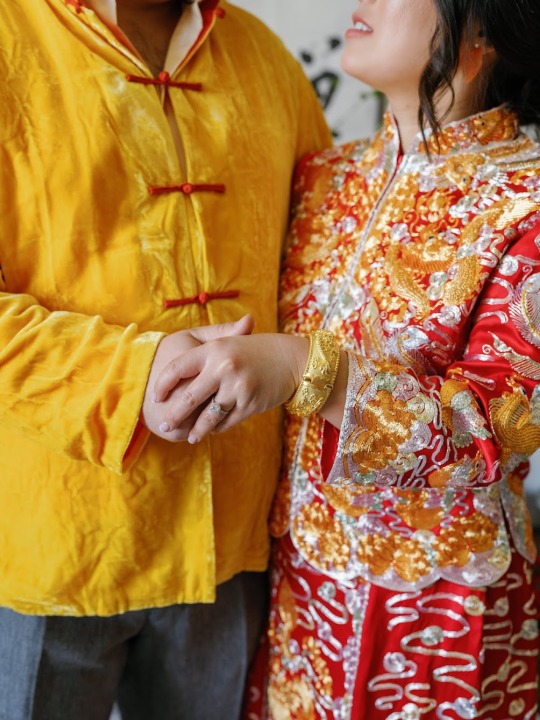#customqipao
Explore tagged Tumblr posts
Text
Celebrating Heritage: The Rise of Multicultural Weddings with Chinese Tea Ceremonies
In today’s world, love knows no boundaries, and neither should weddings. Couples from diverse backgrounds are creating wedding experiences that reflect both personal and cultural identities, resulting in beautiful, meaningful celebrations that blend traditions. One of the most cherished elements in these multicultural weddings is the Chinese tea ceremony, a tradition that has gracefully woven itself into the fabric of modern Western-style weddings. With this blend, attire like the Qipao, Tang suit, and traditional Chinese wedding dresses are taking center stage, symbolizing a deep respect for heritage and the desire to honor family and culture.

The Growing Trend of Multicultural Weddings
Multicultural weddings have become a significant trend, especially among Asian American couples, as they seek ways to honor both Western and Asian cultural traditions. A wedding is a powerful time to connect with one’s roots, and by including traditions such as the Chinese tea ceremony within a Western-style wedding, couples can seamlessly blend customs that represent who they are. This trend celebrates not only the union of two individuals but also the merging of two cultures, creating a vibrant, meaningful experience for everyone involved.
The Chinese tea ceremony, often held before or during the main wedding ceremony, has become a beautiful way to incorporate Asian traditions. During this ceremony, the bride and groom serve tea to their elders, symbolizing respect, gratitude, and the formal joining of families. For many, it’s the perfect opportunity to wear traditional Chinese attire, such as a Qipao, Tang suit, or the elaborate Chinese wedding dress known as the Qun Kwa or Xiu He Fu. Each piece of clothing adds visual depth and cultural richness, reminding everyone present of the values that anchor the new marriage.

Attire for the Modern Multicultural Bride and Groom
As multicultural weddings embrace the Chinese tea ceremony, the choice of attire has evolved to reflect both tradition and modern style. Qipao (also known as Cheongsam), Tang suits, and Chinese wedding dresses are no longer simply reserved for strictly traditional weddings; they’ve become stylish, meaningful options for couples looking to celebrate their heritage within a Western wedding framework.
For brides, the Qipao is an elegant choice that reflects grace, femininity, and cultural pride. Traditionally a fitted dress with a high mandarin collar, modern Qipaos come in various styles, cuts, and colors. Brides are choosing everything from classic red silk, symbolizing luck, to unique shades like fuchsia and navy to match their wedding themes. Hand-embroidered details such as phoenixes, clouds, and florals are not only visually stunning but carry deep symbolic meanings, representing wishes for happiness, harmony, and love.
The Tang suit has become a fashionable choice for grooms, offering a dignified, stylish look that complements the Qipao beautifully. Made with luxurious fabrics like silk and featuring intricate embroidery, Tang suits are ideal for multicultural ceremonies, blending elegance with cultural heritage. While red is a popular choice, grooms are also opting for other colors like dark blue or even subtle gold to coordinate with their partner’s attire. The Tang suit’s versatility allows it to transition from the tea ceremony to the Western wedding, creating a cohesive look across both parts of the celebration.

Chinese wedding dresses such as the Qun Kwa and Xiu He Fu are ornate, two-piece outfits traditionally worn by brides during the tea ceremony. Adorned with embroidery of dragons and phoenixes—symbols of marital harmony—these dresses honor the couple’s heritage in a way that’s both timeless and regal. Increasingly, brides are choosing to wear a Qun Kwa for the tea ceremony before changing into a Western wedding gown, achieving the perfect blend of East and West on their special day.
Preserving Tradition Through Modern Custom Designs
The popularity of multicultural weddings has inspired designers to reimagine traditional Chinese attire with a modern twist. Jinza Oriental Couture in Los Angeles, for example, specializes in crafting custom Qipao, Tang suits, and Chinese wedding dresses that blend ancient techniques with contemporary styling. Each piece is made locally, offering clients the opportunity to incorporate family symbolism, unique color choices, and personal touches.
Hand embroidery is a hallmark of Jinza Oriental Couture’s designs, incorporating both Shu and Panjin embroidery techniques to bring each garment to life. Shu embroidery, known for its vivid and lifelike nature-inspired designs, is often used to depict elements such as peonies and phoenixes, representing beauty and harmony. Panjin embroidery, bold and dramatic, lends itself to more intricate, statement designs, such as the detailed dragons often seen on wedding attire.
Choosing custom attire allows couples to infuse their personalities and cultural heritage into their wedding day. The process of creating a bespoke Tang suit or Qipao begins with a consultation, where each client’s story, tastes, and values are explored. By integrating these personal elements into their attire, couples not only honor tradition but also create heirloom-quality garments that will be cherished by future generations.
Incorporating Chinese Attire into a Western Wedding
In many multicultural weddings, the Chinese tea ceremony is held as an intimate event, perhaps before the main ceremony, allowing for a wardrobe change that highlights both Western and Eastern styles. Brides might begin the day in a traditional red Qipao or Qun Kwa for the tea ceremony, then switch to a Western gown for the reception. This fusion of attire is becoming increasingly popular, as it allows couples to honor their cultural heritage while enjoying the traditional Western wedding experience.
For guests, this layered approach to attire creates a richer visual and emotional experience. They witness not only the beautiful Chinese customs but also the couple’s journey to honor their heritage in a way that is authentic and heartfelt. The Tang suit, Qipao, and Chinese wedding dress each tell a story, adding depth to the ceremony and showcasing the thought and care behind each choice.
Embracing Modern Heritage
The trend of incorporating Chinese attire into multicultural weddings is more than a fashion statement—it’s a way of honoring one’s roots and bridging the gap between past and present. As more couples choose to include elements like the tea ceremony in their Western weddings, the demand for traditional attire continues to grow. Yet, each garment represents more than tradition; it’s an art form, a statement of pride, and a reflection of the wearer’s story.
By choosing to wear a custom Tang suit, Qipao, or Chinese wedding dress, couples make a conscious decision to preserve the craftsmanship and beauty of these traditional garments. Designers like Jinza Oriental Couture are helping to keep these traditions alive, applying hand embroidery techniques to modern fabrics and silhouettes to create pieces that resonate with today’s couples. This fusion of old and new symbolizes the journey of multicultural couples as they navigate the beautiful blend of heritage, love, and new beginnings.
In a world that celebrates diversity and unity, multicultural weddings with Chinese tea ceremonies offer a unique way for couples to honor their heritage. Through thoughtfully chosen attire, couples can bring together their cultures in a way that is meaningful, stylish, and deeply personal. Whether it’s a hand-embroidered Qipao, a bespoke Tang suit, or a regal Chinese wedding dress, each piece tells a story, blending tradition with modernity and making the wedding day truly unforgettable.
#chinese wedding dress#los angeles#qipao#tang suit#multiculturalweddings#chineseteaceremony#customqipao
0 notes